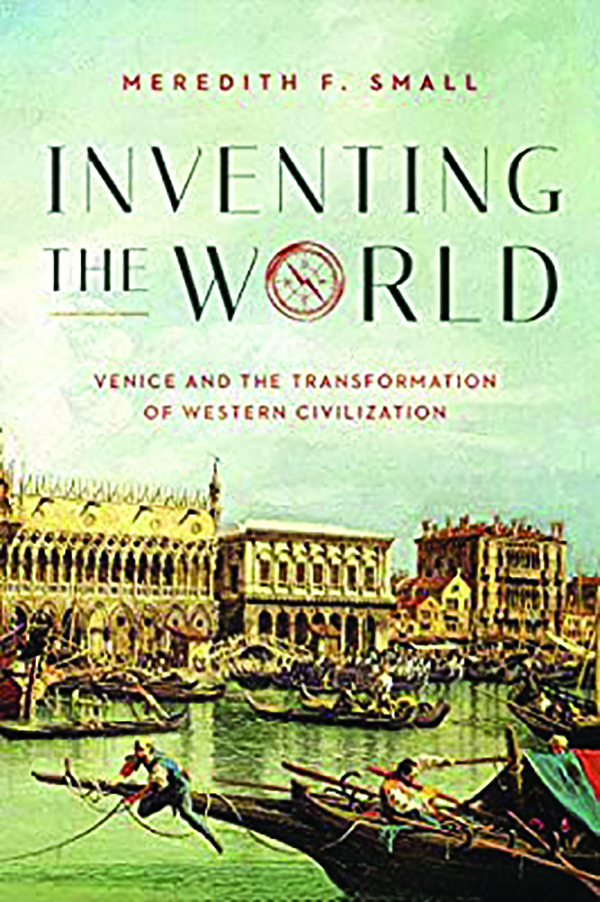What do the logarithmic calculator, crystal glasses, ballistic algebra, and the Frank Capra movie It Happened One Night have in common? The answer to this apparently obscure quiz is provided in Meredith Small’s delightful and erudite study of one of the best-and-least-known cities in the world: Venice. “Like most tourists,” admits Small, “I had thought of Venice as a pretty place in an unusual setting,” but her research for Inventing the World: Venice and the Transformation of Western Civilization led her to a very different conclusion: “Venice is a place of action and innovation.” Venice remains one of the world’s most visited cities, and like New York, its vistas and architecture form part of the collective imagination, even for those who have never been there. Yet Small proposes that its vast contribution to Western culture has been latterly overlooked. “Venice,” she claims, “invented our world.”

Combining anthropology, archaeology, archive research, and its author’s personal experience, Inventing the World traces the origins of Venetian exceptionalism. It begins with the city’s geography: The unique wetland of the Venetian lagoon provided a natural defense for the ancient settlers who learned to navigate its ever-shifting channels. With scarce natural resources, early Venetians were obliged to look to trade and enterprise in order to flourish, developing a combination of curiosity and risk-taking that produced not only the magnificent civilization that became known as “La Serenissima” but also the longest surviving republic the world has known.
The list of inventions with which Venice can be credited is as extraordinary as it is eclectic: It includes the water current meter, printed punctuation, sunglasses, mounted guns on ships, and a particularly popular though unfortunately lethal cosmetic known as “ceruse,” which was extracted from white lead. Venice led the world in public policy, introducing the national bank, public legal defense, child labor legislation, and free public drinking water. Bibliophiles will rejoice in the chapter on the publishing industry, which includes details of the world’s first printed Talmud in Hebrew, the first printed cookbook, and the first newspaper, or “gazette,” which like so many words from the Venetian dialect, such as “ciao” or “ballot,” remains with us today. The section on medical advances astonishes in its recasting of the sophistication of medieval medicine, though it also observes that research at the University of Padua, which for centuries formed part of Venice’s territories, is responsible for the rigors of the calorie-controlled diet.
These are only a fraction of the innovations whose origin Small traces to Venice, yet Inventing the World has ambition beyond the collation of endlessly engaging facts. The book is concerned with why a collection of islands on the neglected northeast coast of Italy came to dominate colonies that stretched from Brescia to the Bosporus. Small offers two key theories: either Venice possessed an “origin myth” that allowed its citizens to believe that they were special, or they were the most “ruthless” traders on the planet. Glamorous, elegant, and lovely though the city might have become, at the end of the day, it ran on cold hard cash. Marco Polo’s feted explorations, as well as the lesser-known but highly influential voyages of the Zeno brothers around the North Sea and Niccolo de Conti in Asia, were made less in the spirit of heroic adventure than in the blunt pursuit of markets. From the inviolable security of the lagoon, Venice was always looking outward, and the cosmopolitan interest in other people and places was a form of latter-day data gathering, identifying potential customers and how to exploit them. Maintaining trade monopoly at sea led to perhaps the most significant Venetian invention of all, the vast military-industrial complex of the Arsenal, the immense boatyard that still occupies more than a sixth of the city’s surface. More than 600 years before anyone had heard of Henry Ford, Venice had established the practice of the industrial production line, turning planks and rope into a fully fitted, crewed, and provisioned galleon in a matter of hours.
Small’s impressive scholarship is enlivened by her experiences of living in Venice: learning to row in the standing, front-facing style first developed over 1,000 years ago, making lace on the island of Burano, absorbing the close-knit atmosphere of the “calli,” or alleyways, whose pattern of ancient proximity has produced a proud and vital, though diminished, community. Shopping at the Rialto Market, she is informed by a stallholder that the correct way to make spaghetti carbonara requires the rejection of parsley and the purchase of heavy cream. “I wanted to do things the right way, the Venetian way,” she recalls. But there’s nothing Venetian about carbonara: It was invented in Rome during World War II and does not include cream, but cream is much more expensive than parsley. This mild scam proves the truth of Small’s thesis that “Venice was more about money than it was about amassing political power or owning land.”
In this sense, the carbonara ruse is precisely Venetian, but Inventing the World concludes powerfully with a chapter on the consequences of this focus on profit: the tourist monoculture that is now destroying the city. Venice is identified as “the father of capitalism,” but the relentless exploitation of the San Marco brand and its attendant environmental damage might prove fatal. This is a passionate book that ends with a heartfelt plea for recognition not only of Venice’s status as one of the most beautiful cities in the world but also for its gift to Western culture: “a way of life on the water that shows by example what humankind in its inventive glory can accomplish.”
Lisa Hilton is a writer and journalist living in England.

